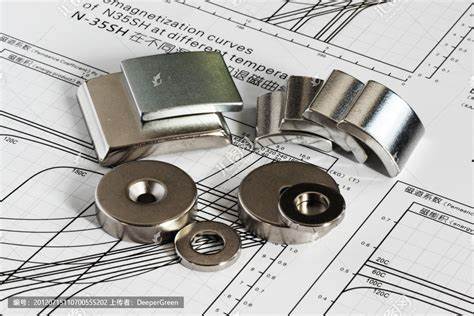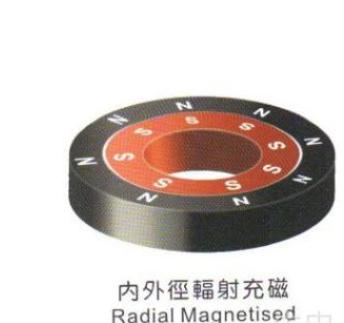Since the advent of NdFeB permanent magnet materials, it has attracted much attention for its superior magnetic properties. It is called the "magnet king". With the continuous growth of market demand, the production process and magnet performance of NdFeB have also continued to develop and improve. We generally use the remanence, coercivity and maximum magnetic energy product to measure the performance of magnetic materials.
Remanence Br
If the magnet is compared to a sponge, the residual magnetism is like a sponge that has absorbed water and is saturated. The magnetic force value of the magnet is displayed at this time. It refers to the magnetic induction intensity of a magnet that is magnetized by an external magnetic field in a closed-circuit environment until the technology is saturated and then the external magnetic field is cancelled.
Coercivity Hcb and intrinsic coercivity Hcj
The water in the sponge is absorbed to the maximum, and then the water is pressed out. When there is no water in the sponge, the pressure used is like coercivity. It is the value of the reverse magnetic field strength required to reduce the magnetic induction intensity to zero when the magnet is magnetized in the reverse direction. However, the magnetization of the magnet is not zero at this time, but the applied reverse magnetic field and the magnetization of the magnet cancel each other out. At this time, if the external magnetic field is removed, the magnet still has certain magnetic properties. The intrinsic coercivity is the strength of the reverse magnetic field required to reduce the magnetization of the magnet to zero.
Maximum magnetic energy product (BH)max
The sponge is saturated with water, and the total amount of water inside can be understood as the maximum magnetic energy product. It represents the magnetic energy density established in the space between the two magnetic poles of the magnet, that is, the magnetostatic energy per unit volume of the air gap. It is the maximum product of Br and Hcj. Its size directly indicates the performance of the magnet.
Today,we will talk to you about what determines the above performance of NdFeB magnets, how to improve the performance of magnetic materials through technical means, and how to avoid the performance of magnetic materials without loss during use.The raw material composition and production process of NdFeB strong magnetism determine its innate magnetic performance. After it becomes a strong magnetic product, its working environment (including temperature, humidity and other factors) will affect its innate magnetic performance, improper use Otherwise, permanent demagnetization will occur.
1. The influence of raw material composition on the magnetic properties of NdFeB
As the name suggests, NdFeB magnetic material is a magnetic material made of rare earth metal neodymium, pure iron and boron by powder metallurgy. In order to further improve the magnetic properties of NdFeB, it can be based on the ternary Nd-Fe-B material Other elements are further added, but the effect of the addition of elements on the performance of the magnet may be bidirectional. The additional elements should be determined according to the specific requirements of the use of neodymium iron boron strong magnetism.
2. The influence of production process on the strong magnetic properties of NdFeB
In order to obtain high-performance neodymium iron boron permanent magnets, new technologies and new processes continue to emerge. In the production process of sintered NdFeB, the main problem is to prevent the precipitation of the α-Fe phase and the oxidation of the alloy. It is difficult to obtain the ideal microstructure. In order to solve these problems, new methods and processes are constantly emerging in practice, such as: Add anti-oxidants and lubricants, and adopt the rapid quenching strip method to prepare magnets; steel ingot homogenization treatment and sheet casting process; two-phase preparation process; wet pressing forming process, etc.
The biggest advantage of adding antioxidants is that the oxygen content of the final magnet is reduced, and the magnetic powder can be ground finer, which is conducive to improving the coercive force. In addition, due to the reduced oxygen content, it is also conducive to improving the coercive force. Compared with the traditional process, the intrinsic coercivity of the magnet with antioxidant added can be increased by about 160kA/m.
After adding lubricant, the friction between the magnetic powder is reduced, the fluidity of the magnetic powder is improved, the degree of orientation is improved, and the remanence is improved.
The thickness of the NdFeB strip prepared by the stripping method is 0.25~0.35mm, which can completely eliminate the α-Fe phase. Due to the enhanced oxidation resistance of the powder prepared by the ribbon spinning method, the magnet grain size becomes smaller and the coercivity is greatly improved.
3. The influence of working environment on the magnetic properties of NdFeB
Temperature: NdFeB magnets have strict working temperature limits. When the working temperature is higher, the magnet may demagnetize, and when the temperature is higher than the Curie temperature, the demagnetization of the magnet will be irreversible.
Humidity: Sintered NdFeB is a magnetic material pressed by powder metallurgy technology. Its internal structure has voids and is very easy to oxidize. Therefore, sintered NdFeB will be treated with coating for corrosion protection. But the coating cannot fundamentally deal with the influence of environmental humidity on the magnet. The drier the environment, the longer the magnetic properties of the magnet.





